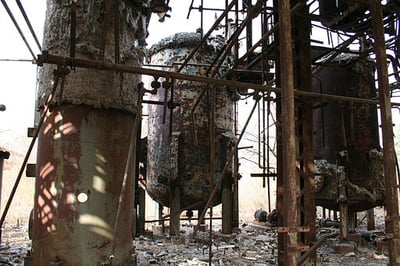
In our previous post, we explained one of the first events in history that led to the creation of Environmental Health & Safety. After the Seveso Disaster of 1976 near Milan, Italy, industries operating in proximity to harmful chemicals began a systematic approach to implementing proactive safety measures.(http://creativecommons.org/licenses/by-sa/2.0)], from Wikimedia Commons)
While western countries began legislative processes of ensuring the health and safety of people and the environment, eastern countries were just beginning to experience their industrial boom. While the Seveso Disaster was the result of engineering failures and lack of proper equipment; the Bhopal Disaster was one of complete negligence, lax management, and a lack of proper maintenance of the facility.
Environmental Disaster Due to Poor Health & Safety Training
In 1984, over half a million people in Bhopal, India, were exposed to a harmful gas that was a component of the pesticide Sevin. By that time, most chemical processing plants had moved away from using the toxic gas (MIC) that was released, but the safer process was more expensive. It’s important to note that this major disaster wasn’t the first accident at the plant in Bhopal. For eight years leading up to the 1984 accident, there were several occurrences of injury, releases, and even a fatality. Many of these prior instances could have been avoided by using simple PPE gear.
Poorly-maintained pipes caused a thermal runaway reaction, similar to the incident in Seveso. An exothermic reaction began, bringing the tank pressure up until emergency venting occurred — releasing 30 metric tons of MIC into the air over Bhopal.
The Cost Of Poor Health & Safety Training in Bhopal
Thousands died in a matter of hours. Trees dropped their leaves, animals died. Temporary hospitals had to be built to deal with the human injury. It’s estimated that the immediate death toll was around 8,000 within the month. A 2014 report estimated that thousands still have serious medical conditions related to the accident.
It was on the heels of these two (Seveso, Bhopal) major environmental disasters that the discipline of Environmental Health and Safety was born.
Today, Environmental Health & Safety is not just for industries dealing with volatile components. Environmental Health & Safety training is critical for any organization. The most important aspect of any project, process and/or business is the safety and welfare of the employees and neighboring communities. With proper Health & Safety training, these accidents could have been avoided and lives saved.
The Profitability Benefit of Environmental Safety & Health Training
Most regulatory entities like OSHA, DOT, and the EPA have baseline requirements for most companies to comply with, or risk penalization. Environmental Health & Safety training programs go beyond the minimal federal regulations. Talon/LPE not only has the ability to bring your company into federal compliance with our training programs, but we can also offer additional training to increase your organization's efficiency, thus increasing profitability. A safer work environment is a more efficient work environment.
Contact us today for consultation regarding how Talon/LPE can help you achieve a more efficient work environment with Environmental Health & Safety Training.

